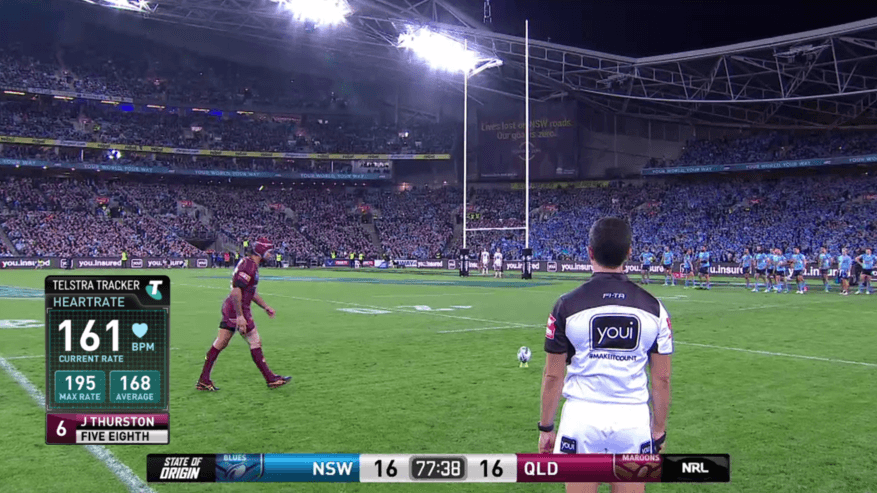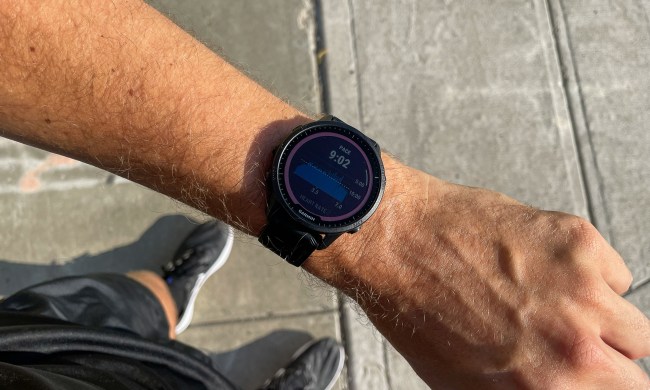
Technology is reshaping every aspect of our lives. Once a week in The Future of series, we examine innovations in important fields, from farming to transportation, and what they will mean in the years and decades to come.
With the clock running out and the chance for a crucial victory in sight, Australian rugby star Johnathan Thurston lined up for a potentially game-winning kick. What was running through his head? Nerves? Was he replaying past success, or dwelling on mistakes and growing anxious?
Nope. He was as cool as a cucumber for the entire country to see, because his biometric data — his real-time thumping heart rate, max, and average — was being broadcast live along with the match. In fact, his pulse actually came down from earlier peaks, a triumph of training over nerves.
This isn’t a futuristic vision of where sports might go: The match happened in Queensland in 2017, thanks to wearable tech company Catapult Sports — and it’s just a clue about where the future of sports might go.
Today: What happens when biometrics and athletes meet?
Watch an ordinary sporting event on TV, whether it’s America’s pastime or a gridiron grudge match, and you might not realize the extent to which technology has already changed the game. Sure, data reimagined baseball years ago thanks to sabermetrics, but that was really just the first page of the spreadsheet. The stats were different, but the players and coaches hadn’t evolved a whit. And a new crop of companies aim to tackle that.
“We’re trying to solve the puzzle of human performance,” explained Tal Brown during a recent panel on the intersection of tech and sports. Brown is CEO of Zone7, which makes a data-driven A.I. system that studies the performance of elite athletes in order to transform the role of the coach by offering insights that simply weren’t possible when Barry Bonds was slugging. How hard was he working? Was he at the top of his game or on the way out?
“We’re trying to solve the puzzle of human performance.”
“Two decades ago, trainers had no way to know what the sweet spot was,” points out John Coulson, director of partnerships for Catapult. Today, the wearable sensor his company makes — which fits into a vest and is worn snugly between the shoulder blades — measures 1,000 data points per second. Combined with sleep data, biometrics from wearables such as smartwatches, GPS data and inertial sensors, and more can tell a modern coach the specific exertion level of anyone at any time.
Transmit this in real time to the sidelines and a coach can see the actual demand on any given athlete. Is Patrick Mahomes up for a QB sneak? Today, there’s no need to guess. Real-time data can be useful in risk assessment as well. In baseball, injuries can sideline a player and reshape a team’s playoff hopes. According to a recent analysis of the 2019 season, Zone7’s A.I. could have detected 45 key injuries to pitchers in advance — fully 70 percent of them. Sabermetrics? This is sabertooth tiger metrics.
Tomorrow: Faster networks will transform coaching
Technology like that from Zone7 and Catapult is really in its infancy, and the study of biometric data is just beginning. Consider the ongoing quest for real-time blood pressure data, or the sudden interest in VO2 max data, a measure of how much oxygen your body consumes during a workout. All that said, one of the biggest challenges to real-time analysis lies in moving data around.
Faster networking is a crucial aspect, and 5G can absolutely do it. I visited a Formula One racetrack in Barcelona recently, where the incredible Lewis Hamilton and Team AMG Petronas showed me firsthand how data has transformed the world’s fastest sport. An F1 car is blanketed by an incredible array of sensors – even the tires have them – letting a pit crew pull 2TB of data from a car in a single weekend of racing. The melt point of the tires is measured by integrated sensors. The scorching of the track is analyzed and recorded by thermal imaging cameras under the front nose cone. And with 5G, that data is beamed to pop-up data warehouses for instant analysis. Substitute “athlete” for “car” and you’ll see the future of sports.
“More and more, we’re seeing the compute element and the human element coming together,” Tom Fitzpatrick with Mercedes-AMG Petronas Formula One team told me at the time.
Substitute “athlete” for “car” and you’ll see the future of sports.
With 5G blanketing arenas and stadiums, tomorrow’s coaches will be able to make real-time calls on individual plays based on data, not just gut instinct. Which players are available, what strength does the opposing team have that needs to be addressed, and who has the specific assets needed to attack it? Real-time biometric data will transform the fan experience, too. Imagine a feed on your smartphone showing the overall strength left in your fantasy roster. Will my team be able to gut it out, given the reserves they’ve got in the tank? How fast did Megan Rapinoe run, how high did Kevin Durant just jump? What metrics will we be able to place bets on in the years to come?
Data will shape our understanding of how far an athlete can go, and what her career looks like. In the past, it was easy for a talent scout to dismiss someone as “injury prone.” Deep biometric data analysis will reveal truths, rather than gut feelings. And it will help extend careers — something every fan can appreciate.


